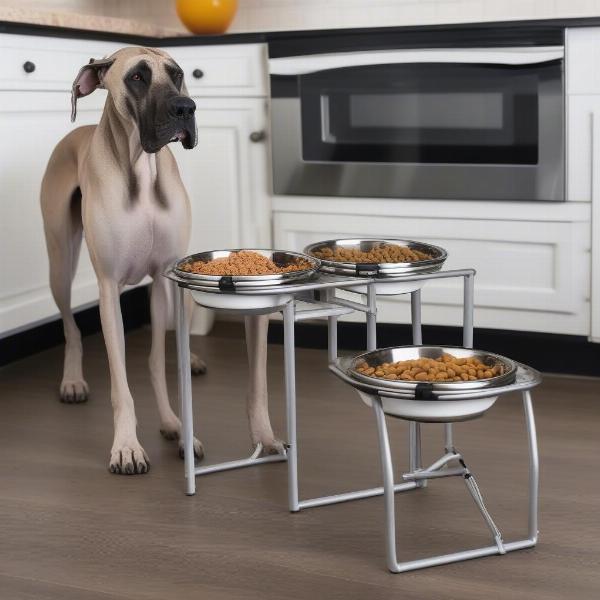The right dog food and water bowl can significantly impact your furry friend’s health and happiness. From material and size to design and placement, choosing the perfect dog food and water bowl involves considering your dog’s breed, age, eating habits, and overall lifestyle. This guide explores everything you need to know about selecting the ideal dog food and water bowl for your canine companion.
Understanding the Importance of the Right Dog Food and Water Bowl
A suitable dog food and water bowl goes beyond simply holding food and water. It can prevent health issues, promote proper eating posture, and even make mealtimes more enjoyable for your dog. The wrong bowl can lead to whisker fatigue, indigestion, and even behavioral problems. Choosing wisely is an essential part of responsible dog ownership.
Material Matters: Exploring Different Dog Bowl Options
Dog bowls come in a variety of materials, each with its pros and cons. Stainless steel is a popular choice due to its durability, ease of cleaning, and resistance to bacteria. Ceramic bowls are another excellent option, often featuring attractive designs and being dishwasher-safe. Plastic bowls are lightweight and inexpensive, but they can be easily chewed or scratched, harboring bacteria.
Size and Shape: Finding the Perfect Fit for Your Dog
The size and shape of the bowl are crucial for your dog’s comfort and well-being. A bowl that’s too small can lead to spills and frustration, while a bowl that’s too large can be awkward for smaller dogs. Deep, narrow bowls are suitable for dogs with long ears, preventing them from dipping their ears into their food or water. Wide, shallow bowls are better for brachycephalic breeds like Pugs and Bulldogs.
 Elevated Dog Bowls for Large Breeds
Elevated Dog Bowls for Large Breeds
Addressing Specific Needs: Bowls for Puppies, Senior Dogs, and Special Cases
Puppies benefit from shallow bowls that are easy to access. Senior dogs may require elevated bowls to reduce strain on their necks and joints. Dogs with specific health conditions, such as megaesophagus, may need specialized bowls designed to facilitate swallowing. Consider large dog water and food bowls for larger breeds.
Location, Location, Location: Placing Your Dog’s Bowls Strategically
Where you place your dog’s food and water bowls can also affect their eating habits. A quiet, accessible location away from high-traffic areas is ideal. For multi-dog households, separate feeding stations can prevent competition and resource guarding. Consider food and water bowls for dog crate if crate training your dog.
Keeping it Clean: Hygiene and Maintenance of Dog Bowls
Regular cleaning is essential to prevent bacterial growth and maintain your dog’s health. Wash your dog’s bowls daily with hot, soapy water, or in the dishwasher if they are dishwasher-safe. Stainless steel and ceramic bowls are generally easier to clean than plastic bowls.
Beyond the Basics: Travel Bowls, Slow Feeders, and Other Accessories
Travel bowls are convenient for on-the-go adventures with your dog. Check out our recommendations for dog travel food and water bowls. Slow feeders can help prevent gulping and bloat in dogs who eat too quickly. Other accessories, such as non-slip mats and bowl stands, can further enhance mealtime comfort and convenience. A food and water bowl for dog crate can be useful for training.
Conclusion: Making the Right Choice for Your Canine Companion
Choosing the right dog food and water bowl is a crucial aspect of responsible pet ownership. By considering your dog’s individual needs and preferences, you can ensure they enjoy mealtimes and maintain optimal health. Remember to prioritize materials, size, and placement to create a positive dining experience for your furry friend.
FAQ
- How often should I clean my dog’s food and water bowl? Ideally, daily.
- What is the best material for a dog bowl? Stainless steel is generally recommended for its durability and hygiene.
- Are elevated dog bowls good for all dogs? They are especially beneficial for senior dogs and large breeds.
- Why is my dog pushing his food bowl around? This could be a sign of boredom or a playful behavior.
- What is a slow feeder bowl? It’s a bowl designed to slow down a dog’s eating pace, preventing gulping and bloat.
- Can I put my dog’s ceramic bowl in the dishwasher? Most ceramic bowls are dishwasher-safe, but always check the manufacturer’s instructions.
- What are the best travel bowls for dogs? Collapsible silicone bowls are a popular and practical choice.
ILM Dog is a leading international online resource dedicated to providing expert advice on all aspects of dog care and wellbeing. We cover everything from breed selection and health to training, nutrition, and grooming. With a focus on providing practical and reliable information, ILM Dog empowers dog owners worldwide to make informed decisions for their beloved companions. For any inquiries, please contact us at [email protected] or call us at +44 20-3965-8624.